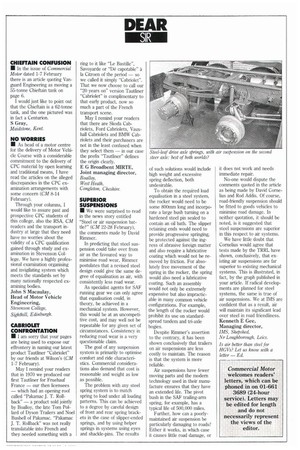SUPERIOR SUSPENSIONS
Page 69

If you've noticed an error in this article please click here to report it so we can fix it.
• We were surprised to read in the news story entitled "Steel or air suspension battle?" (CM 22-28 February), the comments made by David Rimmer.
In predicting that steel suspension could take over from air as the favoured way to minimise road wear, Rimmer postulates that a revised steel design could give the same degree of equalisation as air, with consistently less road wear.
As specialist agents for SAF running gear we can only agree that equalisation could, in theory, be achieved in a mechanical system. However, this would be at an uncompetitive cost, and may well not be repeatable for any given set of circumstances. Consistency in reducing road wear is a very questionable claim.
The goal of any suspension system is primarily to optimise comfort and ride characteristics. Commercial considerations also demand that cost is reasonable and weight as low as possible.
The problem with any steel spring system is to match spring to load under all loading patterns. This can be achieved to a degree by careful design of front and rear spring brackets in the case of slipper-ended springs, and by using helper springs in systems using eyes and shackle-pins. The results of such solutions would include high weight and excessive spring deflection, both undesirable.
To obtain the required load equalisation in a steel system, the rocker would need to be some 800mm long and incorporate a large bush turning on a hardened steel pin sealed to contain an oil bath. The slipper retaining ends would need to provide progressive springing, be protected against the ingress of abrasive foreign matter and also require a lubricative coating which would not be removed by friction. For absolutely free movement of the spring in the rocker, the spring would also need a lubricative coating. Such an assembly would not only be extremely expensive but also impracticable in many common vehicle configurations. For example, the length of the rocker would prohibit its use on standardspread tandem and tri-axle bogies.
Despite Rimmer's assertion to the contrary, it has been shown conclusively that trailers on air suspensions are less costly to maintain. The reason is that the system is more reliable.
Air suspensions have fewer moving parts and the modern technology used in their manufacture ensures that they have an extended life. The pivot bush in the SAP trailing-arm spring, for example, has a typical life of 500,000 miles.
Further, how can a poorlymaintained air suspension be particularly damaging to roads? Either it works, in which case it causes little road damage, or it does not work and needs immediate repair.
No-one would dispute the comments quoted in the article as being made by David Cornelius and Rod Addis. Of course, road-friendly suspension should be fitted to goods vehicles to minimise road damage. In neither quotation, it should be noted, is it suggested that steel suspensions are superior in this respect to air systems.
We have little doubt that Cornelius would agree that tests made by the TRRL have shown, conclusively, that existing air suspensions are far superior to existing mechanical systems. This is illustrated, in fact, by the graph published in your article. If radical developments are planned for steel systems, the same is true of air suspensions. We at IMS arc confident that as a result, air will maintain its significant lead over steel in road friendliness. Kenneth E Gee, Managing director,
1MS, Shepshed, 1Vr Loughborough, Leics.
Is air better than steel for HGVs? Let us know with a letter — Ed.




















































































































































